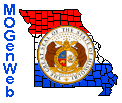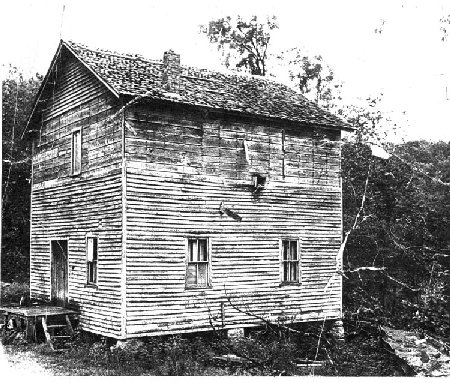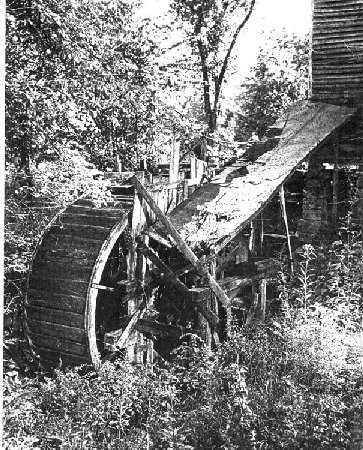

A presentation to the Dallas County Historical Society by Linda Crawford, reprinted here with the permission of the author.
There were six known mills on Mill Creek at Celt Missouri in northeast Dallas County. Their existence spanned about 90 years.
Richard and Rachel Harper Fowler were my third great grandparents. They are buried in the Fowler-Hurst Cemetery near the springs and the site of the first mill. They went to Mill Creek about 1848 from Hart County Kentucky, but according to the 1850 census of Taney County they were in residence there. They did not remain long in Taney County and returned to Mill Creek. No one seems to know when this creek received its name. It has been called the Spring Branch also. The name Mill Creek may have been given to it by the Hurst family as my fifth great grandfather "Mill Creek" John Hurst lived on Mill Creek in Virginia.
Mill Creek has about three and one half miles of steady spring flow. There are five living permanent springs and two wet weather springs on this stream. One spring just below the cemetery still has the rocks around the edge that were supposed to have been placed there by Richard Fowler. The Lyman Allguire family purchased the property after Richard and Rachel and the springs still go by the name of Allguire or Celt Springs. We own a book called THE LARGE SPRINGS OF MISSOURI, a gealogical survey. It was printed in 1944. The following was taken from page 50 of the book.
The best way to get to the first mill site is by foot in one of two ways. Just before getting to Celt as you cross the bridge across Mill Creek there is an old road that goes to the left. It goes to the mill site, cemetery and the home place of Richard Fowler and Pryor Hurst. Another way is to go to the old rock lodge ruins and follow the road behind it down the hill to the mill site. Again you will go by foot.
From 1859 until in the 1940s there were four mill sites on Mill Creek. Richard Fowler and Pryor Hurst's mill was the first mill for two reasons. As far as known it was the earliest mill built. It was the mill nearest the first spring. Richard has been credited with building the first mill, but the original owner of the land where the mill was located was Eli Butts. He is on the original plat map of Dallas County as being the first owner of the land. He may have been a squatter or someone else may have been there also earlier as a squatter. The ledger kept by Richard Fowler and Pryor Hurst begins in 1859 and on July 31, 1860 a payment was made to Eli Butts from R. H. Fowler for the amount of $6.00. This was for the first payment on land and mill. Therefore the mill must have been in operation at that time. The names and dates that follow are in the original ledger which is in possession of a family member.
1859-John Tucher $9.45, 1859-Mac Southard 200 feet weather boarding $2.25,
lathing $175. Also the names of Drury Cooke, V.F.Berry, C. McPheeters, George
Arnold, William Pain, F. Bartlett, P. Watson, L. Admire, W. Crudgington plus
many other names.
In 1866 the two mill owners paid $6.16 in taxes to Thomas P. Welch, Collector of Dallas County. The land description is as follows: 40 acres SE NW, Section 8, Township 36, Range 18; 40 acres NW NE, Section 8, Township 38, Range 18. We don't know when this mill ceased operation other than aftero 1870.
This mill was used for grinding corn and sawing lumber. Richard made coffins for the community from walnut timber. He sawed the walnut for his own coffin and may have possibly made it years before as I have heard from family tales. The wood in these coffins was polished with meat skins and yarn.
One of Richard and Rachel's daughters, Mary Ann, married Claiborne Simmons who was a brother to my second great grandfather John Polk Simmons. Claiborne and Mary Ann lived on Mill Creek also. Mary Ann was a sister to my second great grandfather James Matthew "Jim" Fowler. In the late 1860s after Claiborne returned from the war they bought land on the Little Niangua River between Tunas and Urbana. The walnut lumber used to erect this house was sawn at the Fowler and Hurst Mill at Mill Creek. Pryor Hurst was married to Sarah Jane Fowler, daughter of Richard and Rachel. James Matthew Fowler was married to Mary Elizabeth Hurst, sister of Pryor and daughter of Simpson and Betsy Simmons Hurst. One of the family tales that has been passed down says that Pryor was captured by the rebels during the war and left in a cave for dead. He became dehydrated and had nothing to eat. He lost weight and was able to slip out of the leather thongs and walk home.
The second mill to be erected was not the second mill as far as their line up and down Mill Creek. After the Civil War in 1866 Robert Harrell, who was a brother-in-law of Pryor Hurst, built his mill. Robert married Mahala Hurst. His mill was a planing mill built on the north side of Mill Creek but on the other side of the Celt road. In a few years Robert's son, Rhodeman, added equipment to grind corn. It was called the "middle mill" because at one time when three mills were standing and in use it was truly the "middle mill". Paddy Webster was the last to own the Harrell Mill, saw mill and store. About 1929 the mill was blown away by either a tornado or strong wind. It was never rebuilt. The site is now owned by Jerry Hurst.
The third mill to be built was the second in location on the creek. There is a difference in opinion as to who built this mill. James Matthew"Jim" Fowler, son of Richard, is the one who was creditied with building the mill after Richard's mill ceased operation. Robbie Fowler of Urbana was a son of Simmy, who was a son of James Matthew. Robbie told my mom Minnie Fowler that his grandfather built the mill. Some have said they thought the mill was built by Pryor Hurst. No one knows exactly when this mill ceased operation other than around 1900.
The fourth mill was the Melvin Hurst-George Urie Mill built on the same site as the mill in question above. The men were partners in this venture but according to family history Mr. Urie did not run the mill. This was common for many mill owners. Melvin Hurst was the son of Pryor. Melvin ran the mill for a number of years and then sold his interest to Mr. Urie. Fate Harrell ran the mill for Mr. Urie. At this time each mill built was connected to the previous mill. Although Fate Harrell was not kin to Richard Fowler but to Pryor Hurst. Mr. Harrell ran the mill at two different intervals and then left to run the Bennett Mill at Bryce, now known as Bennett Spring. Melvin bought the mill back from Mr. Urie after about two years. The mill was operated into the middle 1940s. A Westover family was the last to operate the mill. Mr. Westover died and his wife returned to her previous home.

|
Left: Melvin Hurst Mill
Below: Water wheel from Melvin Hurst Mill. Gene and Kathryn Swanigan now own the mill site and provided me with the pictures. The mill stood until in the early to mid 1940s. |
 The fifth mill was the Brakebill Mill which was probably built in the early 1900s. It was about
a quarter of a mile from the Niangua River. Mr. Brakebill was the father-in-law of Fate Harrell,so
again we have a connection to a previous mill. According to postmaster records he owned the
Poynter Mill at Corkery, ran the store there and was postmaster on December 19, 1898. The Poynter
Mill was washed out in 1902 and Mr. Brakebill probably built his mill after this. The mill was in
operation until just before WW I.
The fifth mill was the Brakebill Mill which was probably built in the early 1900s. It was about
a quarter of a mile from the Niangua River. Mr. Brakebill was the father-in-law of Fate Harrell,so
again we have a connection to a previous mill. According to postmaster records he owned the
Poynter Mill at Corkery, ran the store there and was postmaster on December 19, 1898. The Poynter
Mill was washed out in 1902 and Mr. Brakebill probably built his mill after this. The mill was in
operation until just before WW I.
The sixth mill was the McClurken Mill built on the Brakebill Mill site about 1915. Mr. A. Todd McClurken built this mill. It was for grinding corn and ran for about 15 years with a number of different millers. The site is now owned by Chandler and Jackie Hurst Magee who have one of the burr stones from the mill. During WW I Robbie Fowler and my grandfather Ray Fowler remember three mills being in operation. Melvin Hurst was running his mill, Simeon Garrison the Harrell Mill and Mr. McClurken was operating his mill.
There are still visible signs of some of these mills. They are all on private property. I have been priviliged to visit the sites. It is hard at this time to imagine this quiet valley being such a bustling place of activity.
I also found in Fairbanks and Tuck, Past and Present of Greeene County, Missouri, 1915 a mention of William Montgomery being in the part of Greene County in 1833 that is now the Tunas area. The above mentioned finds lead me to believe even more that Mr. Montgomery was the original builder of the first mill.
Gary Swift, Dallas County MOGenWeb coordinator was working on his family lines and found mention of the Fowler and Hurst's Mill in the War of the Rebellion, a compilation of official Civil War Records of both the Union and Confederate armies. The report involves some rebels pursued by Company I, 16th Missouri Cavalry (previously the 6th Enrolled Missouri Militia), which was composed primarily of men from Dallas County, including Captain Morgan Kelly. This report makes it even more likely that Pryor truly was captured. This report follows:
Brigadier-General Sanborn:
John C. Redford, of Dallas County, makes the following [statement]
about the rebels and their pursuit by Captain Kelly:
The rebels left Fowler and Hurst's Mill late last Thursday evening and went six miles northwest from the mill to William Hall's and tarried till after 10 o'clock at night. Captain Kelly and his command arrived at Fowler's Mill a little after dark on the same evening the rebels left and staid all night at the mill, and started on the train the next morning. The same morning that Captain Kelly left the mill the rebels killed eight Union men on the Little Mingo and took three prisioners a [short] distance from where Captain Kelly staid all night. The rebels then went up the Little Mingo to the Adams Settlement, not over eight miles from the mill. The rebels were going, when last heard from, in the direction of Warsaw, or the North Prarie, one hour and a half in advance of Captain Kelly.
I give the statement as Mr. Redford wrote it down.
John Small
Major, Commanding.
Major Small requests you to say to General Sanborn that Mr. Redford states these rebels informed him there in that vicinity that you will have 400 rebels in the State of Missouri; that they had all started together and had scattered in different directions in small squads.
B.
Credit for my presentation also goes to Boone Skinner who wrote The Big Niangua River, Jim Brickley who wrote The Dear Old Book of Hattie Thomas, Melvin and Earl Hurst and my husband Jack who wrote a paper on the area mills for a history class at SMSU. A copy of his paper is in the Dallas County Library in Buffalo MO. Jim Brickley was a good friend and a relative through the Simmons line.
Linda Fowler Crawford
Email:
The
Dallas County MOGenWeb
site is maintained by
Comments and contributions are welcome.
Many thanks to previous coordinators Carmen Boyd and Megan Zurawicz.
Copyright © 1997-2024, all rights reserved.
Last updated:
Monday, 23-Feb-2009 19:01:17 MST